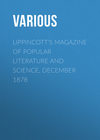Czytaj książkę: «Chambers's Edinburgh Journal, No. 425»
VENICE
At six, on a bright morning, the 1st of September 1851, we left the quay of Trieste in the steamer for Venice. We were in no particular mood upon the subject. If anything, we rather feared that the famous City of the Sea might turn out to have been overpraised. However, we resolved to be candid.
The morning passed pleasantly enough. We admired the snowy tops of the Styrian Alps on the right, and the deep green of the Adriatic was beautiful. We had calculated upon an eight hours' voyage; but it was scarcely eleven o'clock when the pinnacles and towers of the city began to appear above the water's edge to the west, taking us a little by surprise. It was thenceforward an interesting occupation for an hour or so to watch these objects gradually rising out of the waves. By and by, a large dome took its place amongst them; then some little domes and more pinnacles: at length a connected range of city objects lay along the horizon, and this we knew was Venice. The steamer by and by began to wind through some straits or channels of the sea, with fortifications covering the low banks on both sides. It went on; and about one o'clock, under a bright sun, we found ourselves in an open space of sea, opposite the famous series of buildings composed of the Doge's Palace, the Cathedral of San Marco, the Piazza, &c.—objects perhaps of their kind the most generally known in Europe.
The first few minutes was a confused mixture of romantic association and solicitude about a right hotel. Our thoughts slid with prosaic facility from the lion on the top of the obelisk, so well remembered from Canaletti's pictures, to the sign of the Leone Bianca—a place of entertainment not far off, much recommended by Murray. I recalled the Byronian heroines sailing about in those gondolas, which we saw skimming away here and there, and wondered whether it would be best to go to Dameli's or the Emperor of Austria. The first business was to get a gondola for ourselves and luggage; thus, at the very first reducing to the character of a mere cab that picturesque species of conveyance—I, the conductor of the party, wondering all the time how much those two cowled villains would charge me. Seated there with my two ladies, we speedily proceeded along the Grand Canal towards the hotel last mentioned, to try if we could obtain accommodation in it. It was curious to land from a boat at the steps of a house, and walk from the sea into the hall. It was dazzling to see the splendour of the building, with its fine marble vestibule within, and its superb staircases. We did not find in it, however, exactly the range of rooms we required, and we after all returned along the canal, and tried the Hôtel de l'Europe, a similar, but somewhat plainer house, where we got apartments to our mind.
I was curious at first to study the arrangements of houses and streets in Venice. Here I found that what had once been the palace of a noble, presented, first, a ground-floor about three feet above the medium level of the Adriatic, composed of a broad vestibule crossing through from front to rear, with the inferior apartments on each side; second, a floor of good apartments, with an open hall in the centre right over the vestibule—this hall adorned with pictures; third, a similar good floor, with another hall in the centre, which had been the banqueting or dining-room, and was now used as the salle-a-manger of the hotel—and this salle had balconied windows at one end looking out upon the canal. There was, I suppose, a fourth floor of inferior rooms, but there I never had occasion to be. Most of the rooms, looking out at the sides of the building into narrow lanes, were ill-lighted: only those having windows to the front were light or cheerful. The walls, staircases, and floors, were all of marble—the proportions large, and the decorations elegant. The date, 'Jan. 1676,' appeared over an inner door in the salle.
A side-door in the rear of the house gave me exit for a walk into the town. I found myself in a paved lane, here called a calle, with good houses on each side. It led me into a wider lane, which had all the characters of a street, excepting that it was comparatively narrow, and only traversed by people on foot. Here I found shops of many kinds, but almost all on a small scale; as also many stalls for the sale of fruit and other petty articles. Following this way to the right, I soon came to the outside of the great square, which is the principal public place in the city. It was but necessary to go through a wide passage, to find myself in the Piazza—that well-known paved and arcaded quadrangle, which we have seen so often in pictures; the far extremity being closed by the singular church of St Mark, while close by rose the lofty campanile and the three tall flag-staffs. We sauntered for an hour about this grand central region, viewing the outsides of things only, and dreaming of those scenes of the past with which they were connected. After dinner, I again went out by myself to walk through the town, for it was agreed that we should put off regular sight-seeing till next day. Let not the reader be surprised to hear of walking through Venice. It is permeated in all directions by calles and narrow streets, which cross the canals by high-arched stone bridges, thus giving pedestrian access to and from all parts of the city. Certainly, however, no such thing as a leading thoroughfare exists, and it must be difficult for strangers to acquire that local knowledge which will enable them to find their way without a guide. Unlike all other cities, no kind of vehicle, not so much as a wheelbarrow, ever rattles along these narrow, tortuous ways. The gondolas upon the canals are strictly the only conveyances used in Venice. Thus the city has a stillness which, even in its most brilliant days, must have impressed strangers with a sense of melancholy. In our time, when Venice is reduced at once from independence and from wealth, the effect is peculiarly depressing. I felt as if Venice were only a curiosity to look at for a few days, not a place in which any considerable portion of life could be spent with comfort.
Next morning, at eight o'clock, by which time we had breakfasted, a gondola with two rowers waited for us at the porch of the hotel, along with a clever, well-informed youth named Alessandro, who had undertaken to be our cicerone. The charges for both gondolas and guides had, we found, been raised since the late troubles, in common with everything else in Venice, liberty being always somehow a provocative to taxation, whether temporarily or permanently enjoyed. What in 1843 would have cost six English shillings, now stood us eight or nine. The gondola, as is well known, is a long boat, pointed at both ends, and painted black—furnished in the centre with cushioned seats, all black, over which is erected a kind of cot, with windows, to screen the passengers. One man stands in the fore, another in the back part, rowing with their faces forward, the oar working in a twisting manner on the top of a piece of wood curiously grooved for the purpose. I cannot say that I saw anything very peculiar in the dress of the gondoliers, or indeed in the appearance of any of the people of Venice, excepting the female water-carriers. With that exception, the people are dressed in much the same manner as is customary over Europe generally. So far as I recollect, not a single veiled or half-veiled lady, sailing in her own gondola, met our eyes while we were in Venice. We have to revert for all such things to Goldoni's plays and the pages of our own Byron.
The real grand thoroughfare of Venice is the Canale Grande—a wide curving street, which sweeps through a great part of the city. The principal palaces of the nobility, the superbest of the churches, and the best hotels, are placed along this water-street. As we moved along, Alessandro told us, in respectable French, the history of each great mansion, and what its owners had done in the history of the republic: a recital as intelligent and as accurate as could have been expected in a book. Most of these buildings have a melancholy, decayed look, being generally very old, and few of the owners being able to spend much in or on them. A few that look tolerably fresh, are found to be occupied by the post, the customs, or some other office, the insignia of which figure in gaudy colouring over the principal entrance. In connection with most of the palaces, the name of some architect of reputation is mentioned. They are wholly of marble; and, in many cases, round stones of a precious kind, or pieces of marble of a brilliantly veined character, are set in a species of framework in front, communicating a peculiarly rich effect. The least pleasing circumstance connected with these superb mansions, is their being so closely beset by other buildings. We saw only one or two which had any spare space associated with them, to form either a court-yard or a piece of garden-ground. Space is indeed the great want of Venice. Many of the canals, dividing lines of houses as lofty as those of the Old Town of Edinburgh, are not wider than the wynds of that celebrated city. And yet there we see the landing-places and entrances of magnificent mansions, though more frequently the houses on such narrow canals have the air of merchants' stores and warehouses.
It would be vain to attempt a detailed description of one-half of the wonderfully beautiful old churches, palazzos, and other buildings, which we examined during this and the subsequent day. We were agreeably disappointed on the whole; for we had come with an idea that we should see only the shell of ancient Venice, and few of those works of art which used to be associated with its name; whereas the fact is, that all the most remarkable old buildings are entire, and in tolerable order; and scarcely a picture, or statue, or antique curiosity, has been lost during the political changes which the city has undergone. Doubtless, it is living Venice no more: it is Venice reduced to a museum—but what a museum! And here I must do the Austrian government the justice to say, that it appears to have a deep feeling of interest in the ancient monuments of the republic. It contributes handsomely for their maintenance; and no modern proprietor of an old palazzo can make any change in it, till he has satisfied a tribunal of taste, that the change will be in keeping with the antique and picturesque glories of the place.
We went at an early hour one day to see the Pisani palace: one of those which are attractive on account of their containing good works of art. The Pisani are an illustrious family: and the representative still lives in this fine old mansion, or at least occasionally occupies it; but he is a broken-down old man, who has survived wife, children, and other relatives, and his death must speedily close the many-centuried history of his name. It was with melancholy feelings that we stepped into the hall or vestibule, whose broken plasters are still graced with coats-armorial and emblems of ancient dignity; amongst the rest, two standards wrapped up round their staves, probably memorials of the great Pisano—a naval commander of the fourteenth century. The housekeeper's little children were playing about the place, as children in an ordinary city would play in a street among the dogs and carriages. Mounting a wide side-staircase, we reached a handsome first floor, composed of a central salle and side-rooms, tolerably furnished; and here we found the two pictures for which the Pisani are famous—The Death of Darius, and his Queen supplicating Alexander, by Paul Veronese. They are beautiful paintings; and by their value, still give a sort of dignity to this decayed family.
Another palace we visited was that of the Vendramini Colerghi, now the property of the Duchesse de Berri, who makes it her ordinary winter-quarters. It is a large and elegant building, in a form approaching that of the letter Z, with a flower-garden in front of the receding part. The duchesse is understood to have purchased it for 120,000 zwanzigers—equivalent to about L.4000, and not the value of the stones of which it is built. With great good taste, she has made no alteration in the decoration or destination of the rooms, but has added modern furniture, family portraits, and many objects of virtu. The series of apartments on the first floor above the vestibule is extensive and superb; and though the tout ensemble is more characteristic of a modern French princess than of an ancient Venetian family, it was pleasant to see at least one of the palazzos of the ancient republic handsomely furnished, and having the appearance of cheerful occupation. Among the portraits are some that could scarcely have been expected to survive the Revolution of 1792—as Louis XIV.; Louis XV. when a boy; some of the princesses, aunts of Louis XVI.; also the dauphin, father of the latter monarch. There is likewise a beautiful cabinet of Marie Antoinette. Such articles, we presume, must have been obtained from the palaces at the downfall of royalty, and preserved by various accidents till the restoration, when the royal family would of course be eager to recover them at whatever expense. We saw here a portrait of the Duchesse, with her infant son, standing in widow's weeds, beside the bust of her assassinated husband; also portraits of the Due de Bourdeaux, his wife, the Duchesse's present husband, and her younger set of children. In a glass-case were the gilt spurs of Henri IV. The Duchesse gives gay parties in winter, when the full suite of rooms must have a fine effect.
The churches of Venice are numerous—about a hundred in all, being one for every thousand souls, while I am told there is a priest for every hundred. We visited eight or ten of the most remarkable; and so bewildering was their magnificence, and so confounding the multitude of fine things shewn in them, that if I had not taken note of everything at the moment, I must have had only one confused idea of something supra-mundanely fine. A great church in Venice is usually a structure of pure marble, with a dome or tower. The interior is one open space, with the usual double colonnade, a railed off altar-space at the upper end, and little chapels in the aisles on both sides. Generally, over the principal altar is some large scriptural picture—a Crucifixion, or a Taking Down from the Cross, or an Ascension; the production of Titian, or Tintoretto, or Paul Veronese, or some other artist of the Venetian school. Over the lateral altars are similar works of art. Sometimes one of these side-chapels is at the same time the tomb of a noble family, which assumes the duty of keeping it in order. In many of the churches, nothing can exceed the beauty of the sculpture which is lavished over the interior; and, while many features are common, each usually contrives to have some special beauty or some exclusive possession on which a peculiar fame rests. For example, the church of San Georgia Maggiore has some wooden carved-work by a Belgian artist, of surprising beauty. Gli Scalzi is a paragon of elaborate decoration. The church of the Frari, old and Gothic, is full of grand tombs, including those of several doges, that of Titian, and a monument to Canova. The Santa Maria della Salute has a fine collection of pictures over and above those in the church. This church was built in 1632, by a decree of the Senate, as an act of thanksgiving to the Virgin for putting an end to a pestilence by which 60,000 people had been carried off. It is a most beautiful structure, full of fine things; and altogether a curious monument of that delusion of ignorance and misdirected piety which made men assign to a chapter of priests the duty now committed to a Board of Health, and persuaded them that a church was of much greater efficacy for the cure of the pestilence than an hospital.
I have as yet said scarcely anything of the ducal palace and church of San Marco, which are the principal and central objects of Venice. The first is a quadrangular building, with a court in the centre; very peculiar antique architecture, with a double row of arcades both outside and in; the whole having a strikingly Oriental character. In front, and at one side, is a pavement, forming the principal open space in Venice; the haunt, of course, of many loungers of all characters; and distinguished by the two well-known pillars, one of which bears the lion of St Mark. The interior of the palace presents a succession of grand old halls, the scene of the court-glories of the ancient doges. One, called the Sala del Maggior Consiglio, is 154 feet long by 74 broad. It has a dais at one end, on which the throne must have been placed; and over this a picture of Paradise by Tintoretto, covering the entire end of the room—of course 74 feet long—being thus the largest picture ever painted on canvas. Around, under the ceiling, are the portraits of the series of doges. The Sala del Senato still exhibits the seats of the senators, each furnished with its candlestick for protracted discussions—a melancholy memorial of departed independence. We gazed, too, on the Hall of the Council of Ten, and the lesser room where the more terrible Council of Three held its sittings; all now reduced to mere show-places, but still strongly suggesting their original destination. The Lion's Mouth, in the outer gallery, to which any accusation could be committed, was not forgotten. After dwelling a due time upon the rooms, and the numerous pictures and other works of art presented in them, we descended into the dungeons or pozzi—narrow stone-chambers destitute of light, where Venetian justice formerly kept its victims—a terrific specimen of the reckless inhumanity of past times. Finally, we passed to the Bridge of Sighs, which is detected to be an afterthought structure, designed to connect the palace with the more modern prison in the rear, a canal intervening. I suspect, after all, that many of the stories told about the pozzi and the bridge are mere myths, the reflection of ideas which the appearance of the places suggests.
The church of San Marco, adjoining the palace, and forming one side of the Piazza or square, is like no other building I ever saw—decidedly Oriental in style—indeed such a building as Aladin might have evoked by his lamp; which reminds me, by the way, that there is a prevalent tinge of the East all over Venice, seen in the architecture particularly. The vaulting and arching of this church are all described as Byzantine in style, and are therefore round; but it has been a custom in Venice to fix up on such a building as this any reliques of antique sculpture which have been taken in the countries with which the Republic was at war: accordingly, the front of San Marco bristles all over with curious pillars and carvings, including, above all, the four celebrated bronze horses which Napoleon took to Paris, and which were restored after his downfall. Walking through one of the low-browed doors, we pass across a vestibule, where a stone is pointed out in the pavement as the spot on which the emperor Barbarossa laid his head beneath the foot of Pope Alexander III. Then proceeding into the interior, you find the dusky atmosphere dimly blazing with a peculiar glitter from the walls and ceilings, the whole being one mass of gold mosaic, on which scripture subjects are inserted in a darker colouring. Think of a huge church, the interior facing of which is composed of pieces of gilt stone, each no bigger than the point of your finger would cover! But this is not all. The wide-extending pavement is seen to be composed in like manner of small pieces of marble and precious stones, set so as to form regular figures, all most exact, and still wonderfully entire, though it has endured the feet of daily thousands for several centuries. Unfortunately, from some infirmity in the vaulting below, this singular floor is thrown into undulations, in some places so great as to require care in walking over them. I spent hours in wandering about and examining the many curious things which are to be seen in this church, including those of its famous treasury. It is truly surprising that, after so many revolutions, so many of these valuables have been preserved. The fidelity of the priesthood to their charge is surely deserving of some admiration, considering how many opportunities there must have been of making away with precious articles, after which no inquiry would probably have ever been made.
A campanile, or bell-tower, has been erected in the square near the church, and is one of the most conspicuous objects in Venice; rising, as it does, above every other building. It seems slender; but I was surprised to find, on a rough measurement, that the sides are not less than fifty feet wide. A paved way, instead of a staircase, conducts to an open loggia near the top, whence you can have a complete view of the city. I remarked that the tops of many of the houses are of use in the same way as gardens and summer-houses are in other countries. People go there to smoke, or to take their coffee—the chimneys being a very slight obstruction to such enjoyments in a country where little fire is used. We here also had a good view of the celebrated orologio of Venice; a tower containing an ancient clock of peculiar elaborateness of construction. On the top stand two metal giants, armed with ponderous hammers, with which to strike the hours and quarters on a huge bell, placed between them. There is something terrible in these automata; and the feeling is not allayed when you hear that one of them once committed a murder, having with his hammer knocked an incautious workman over the battlements! The campanile was begun in 902; and I felt interested in tracing its resemblance, both in architecture and relative situation, to the square tower of St Andrews, which is supposed to be of nearly the same age.



















